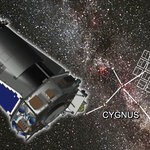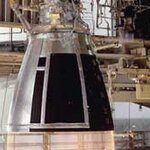Aerospace

Astronomers using the NASA Swift Satellite are tracking a spectacular comet as it closes in on Earth and sheds gas and dust from its vaporized ice.
A comet is a clump of frozen gases mixed with dust. These "dirty snowballs" cast off gas and dust whenever they venture near the sun. Comet Lulin, which is formally known as C/2007 N3, was discovered last year by astronomers at Taiwan's Lulin Observatory. The comet is now faintly visible from a dark site. Lulin will pass closest to Earth - 38 million miles, or about 160 times farther than the moon - on February 24.
The team is studying the comet…

NASA's Kepler spacecraft will soon begin a journey to search for worlds that could potentially host life. Kepler is scheduled to blast into space from Cape Canaveral Air Force Station, Fla., aboard a Delta II rocket on March 5 at 7:48 p.m. Pacific Time (10:48 p.m. Eastern Time). It is the first mission with the ability to find planets like Earth -- rocky planets that orbit sun-like stars in a warm zone where liquid water could be maintained on the surface. Liquid water is believed to be essential for the formation of life.
The mission will spend three-and-a-half years surveying more…

Thanks to advances in satellite technology, college students are giving government intelligence a run for its money. A student geography project from UCLA made waves in the Harvard International review for using principles of wildlife diversity to narrow bin Laden’s likely location to a few promising structures in Pakistan.
Bin Laden has everything in common with a member of a species trying to escape extinction. This allowed the UCLA students used theories of wildlife dispersion to predict his whereabouts.
For example, biogeographical distance-decay theory suggests…

U.S. intelligence officials have spent more than seven years searching for Osama bin Laden but UCLA geographers say that, if he is still alive, they have a good idea of where he was at the end of 2001 — and perhaps where he has been in the years since.
In a new study published online today by the MIT International Review, the geographers report that simple facts, publicly available satellite imagery and fundamental principles of geography place the mastermind behind the Sept. 11 attacks against the U.S. in one of three buildings in the northwest Pakistan town of Parachinar, in the…

This is pretty amazing, although I can't help but be reminded of the morning I came downstairs and discovered that ants had invaded my kitchen overnight.
After clicking play, make sure you click the little "up arrow" in the lower right corner and choose "HQ" to get the full effect.

In physics classes, we are all taught that the acceleration due to gravity on Earth is 9.8 meters/second2. For the purpose of basic physics education, this value is fine - it represents the average value of the gravitational attraction every object experiences at sea level, and is always directed straight down toward the center of the planet. However, the actual gravitational attraction an object experiences is influenced by the presence of irregularities in the shape of the Earth, the non-uniform distribution of mass beneath the crust, and even large buildings. For instance, the spinning of…

The team operating NASA's Mars Exploration Rover Spirit plans diagnostic tests this week after Spirit did not report some of its weekend activities, including a request to determine its orientation after an incomplete drive.
On Sunday, during the 1,800th Martian day, or sol, of what was initially planned as a 90-sol mission on Mars, information radioed from Spirit indicated the rover had received its driving commands for the day but had not moved. That can happen for many reasons, including the rover properly sensing that it is not ready to drive. However, other behavior on Sol 1800 was even…

Captain Chesley "Sully" Sullenberger's heroic Hudson River landing was a good reminder that a twenty pound bird at 200 miles per hour is not so different from a bowling ball shot from a cannon. The results range from minor dents to Flight 1549's disabled engines to the damage below: double-lapped, 1/16” reinforced aluminum totally blown through, and feathers clear to the cockpit.
I learned of Smithsonian’s interest in birdstrikes three months after working on the one pictured below. A coworker at USAirways taped an article to my door urging aircraft personnel to report wildlife strikes…

The recent landing of a Airbus A320 on the Hudson was a tragedy narrowly avoided - thanks in no small part to the quick thinking of the pilot after a flock of birds took out both engines on the plane. But bird strikes unfortunately aren't a new or unusual problem.
Airports and airstrips are pretty controlled environments - designed that way to avoid and eliminate as many safety concerns as possible. But all the controls in the world can't necessarily convince a flock of Canadian geese to avoid the flightpath of a commercial jet. And as we saw on Thursday, the…

On Monday, Jan. 5, NASA issued a request for proposal for the Ares V rocket that will perform heavy lift and cargo functions as part of the next generation of spacecraft that will return humans to the moon. The request is for Phase I concept definition and requirements development for the Ares V rocket. Proposals are due to NASA's Marshall Space Flight Center in Huntsville, Ala., no later than 1 p.m. CDT on Feb. 9.
The request for proposal defines the procurement approach for Phase I of the Ares V acquisition. The contract work will include developing products to enable NASA to…